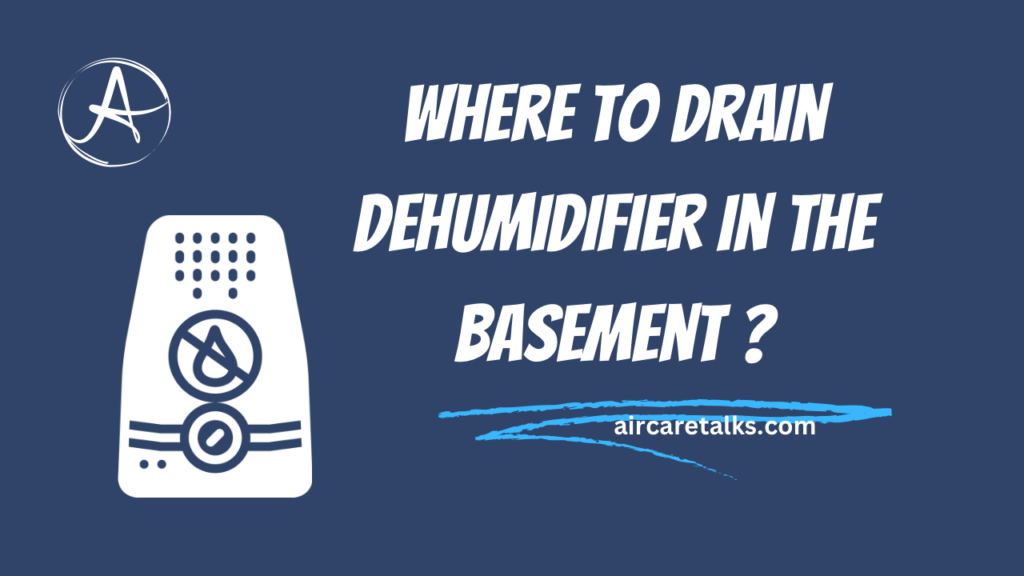
Where to drain dehumidifier in the basement? A dehumidifier is essential for controlling humidity levels and preventing mould growth in damp basements.
However, choosing the right location to drain the water collected by the dehumidifier is important for proper functioning and prevention of water damage.
This comprehensive guide will provide detailed information on the best practices for draining a dehumidifier installed in a basement.
Contents
Where to drain dehumidifier in the basement ?
Choosing a Location
When selecting a location to place your dehumidifier and drain the water, there are several factors to consider:
Proximity to a floor drain – This is the ideal option if an existing floor drain is in the basement. The dehumidifier can drain directly into it through a hose.
Near a sink or laundry area – If there is no floor drain, placing the dehumidifier near a sink or laundry area allows you to drain into these conveniently.
Away from finished areas – Avoid installing the dehumidifier and drain too close to finished living spaces, walls or furniture in the basement. Condensation can damage these areas.
Central location – Select a spot that allows the dehumidifier to effectively control humidity in the largest area possible. This is often in a central location.
Access to a power outlet – The dehumidifier will need a nearby electrical outlet to plug into.
Types of Drains
There are several different options for draining a dehumidifier:
Gravity Drain
This is the most convenient and effective drain method.
The water collects in the dehumidifier’s tank and flows through a drainage hose using gravity into a floor drain or sink.
The hose should slope downward to allow water to flow out easily.
To create a gravity drain:
- Locate the drainage outlet on the dehumidifier, usually at the back bottom area.
- Attach a 1/4 inch or 5/8 inch diameter plastic hose (often included) to the outlet.
- Run the hose to a floor drain or sink drain port. Make sure it is firmly attached.
- Use hose clamps or zip ties to secure the hose and prevent leaks.
- Ensure the hose slopes downhill so water does not flow back into the dehumidifier.
Pump Drain
If there is no accessible floor drain and the dehumidifier is too far from a sink, a pump can drain the water.
An internal or external condensate pump pushes the water through a drainage hose up to 15 feet vertically or 50 feet horizontally to reach a suitable draining point.
For an internal pump:
- Choose a dehumidifier with a built-in pump and outlet for attaching a drainage hose.
- Follow a similar setup as the gravity drain.
For an external pump:
- Purchase an external condensate pump.
- Place it below the dehumidifier outlet.
- Run a hose from the dehumidifier outlet to the pump inlet.
- Run another hose from the pump outlet to a drain.
- Make sure hoses are securely attached on both ends.
Laundry Sink Drain
If a laundry sink exists in the basement, this can be a convenient drain location:
- Place the dehumidifier within about 6 feet of the laundry sink.
- Attach a drainage hose to the outlet and run it over to the sink.
- Secure the hose end inside the sink drain port using a zip tie or clamps.
- Make sure the hose slopes downward into the drain.
Floor Drain
Draining directly into an existing floor drain in the basement is the most ideal option:
- Place the dehumidifier within 6 to 8 feet of the floor drain.
- Attach the drainage hose to the outlet.
- Run the hose to the drain port, securing it with zip ties or clamps.
- Make sure the hose slopes down into the drain.
- A drain cover can be used to prevent any blockages or backups.
Sump Pump Pit
Draining into the sump pump pit is another possibility if a floor drain is not available:
- Locate the dehumidifier within about 5 feet of the sump pit.
- Run the drainage hose into the sump pit. Secure it so it does not move around.
- Ensure the hose outlet remains above the water level to prevent backflow into the dehumidifier.
- Check that draining into the sump does not overwhelm or clog the pump.
- Condensate Pump into Drain or Sink
For long drain distances from the dehumidifier:
- Purchase an external condensate pump and place it below the dehumidifier outlet.
- Run a hose from the dehumidifier outlet into the pump inlet.
- Attach another hose from the pump outlet to a distant floor drain, sink, or condensate pump outlet.
- Make sure all connections are securely fastened.
Preventing Leaks and Backflow
To prevent water leaks, flooding and backflow into the dehumidifier:
- Use hoses specifically designed for dehumidifier drainage. Check that they are the right diameter.
- Ensure drainage hoses are completely sealed and secured using clamps, zip ties or adapter fittings.
- Check slopes regularly and avoid any uphill sections where water could flow backward.
- Keep bends and turns in hoses to a minimum.
- Ensure the hose’s end is firmly secured and cannot come loose from the drain.
- Consider using trays or buckets under drainage hose connection points to catch leaks.
- If draining into a sump pit, position the hose end safely above the water level.
- Follow dehumidifier manufacturer guidelines for proper drainage.
Conclusion
Choosing the ideal location and drain setup for a basement dehumidifier requires careful planning and adherence to installation guidelines.
Key factors include proximity to existing drains or sinks, away from finished walls and furniture, proper hose slopes to prevent back flow , securely fastened connections, regular maintenance and following manufacturer instructions.
While a floor or sink drain is most convenient, pump drains or creative options can accommodate basements without readily available gutters.
With a quality dehumidifier and properly designed drainage, you can enjoy a dry, comfortable basement safe from mould and moisture damage.